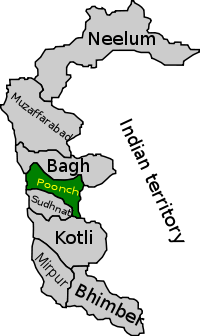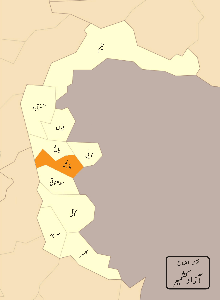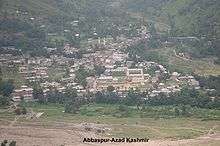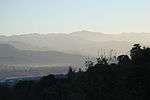Poonch District, Pakistan
| Poonch district, Kashmir | |
|---|---|
| District | |
| Poonch | |
 Map of Azad Kashmir with Poonch highlighted | |
| Coordinates: 33°51′14″N 73°45′03″E / 33.8540°N 73.7507°ECoordinates: 33°51′14″N 73°45′03″E / 33.8540°N 73.7507°E | |
| Country | Pakistan |
| Province | Jammu and Kashmir |
| Headquarters | Rawalakot |
| Area | |
| • Total | 855 km2 (330 sq mi) |
| Population (2017) | |
| • Total | 500,571 |
| • Density | 585/km2 (1,520/sq mi) |
| Time zone | UTC+5 (PST) |
Poonch (Urdu: ضلع پونچھ ) is one of the 10 districts of Azad Jammu and Kashmir. Poonch district borders Indian-administered Kashmir and is part of the greater dispute between India and Pakistan.
The capital of the district is Rawalakot. It has a population of 500,571 according to the 2017 Census.[1]
History
From the end of seventeenth century up to 1837 CE, Poonch was ruled by the Muslim Rajas of Loran in Tehsil Haveli. It then fell into the hands of Raja Faiztalab Khan of Rajouri to whom it was handed over by the Punjab Government. Poonch was included in the transfer of the hilly country to Maharaja Gulab Singh of Jammu and Kashmir in 1848. Before this transfer, Poonch was considered a district of Lahore. Maharaja Gulab Singh granted Chibal, Poonch and other areas to Jawahar Singh and Moiti Singh. The Raja of Poonch had to present to the Maharaja one horse with gold trappings. The Raja of Poonch was not to effect any administrative changes in the territory of Poonch without prior consultation with the Maharaja of Kashmir.
Separation of Poonch

After independence in 1947, Pakistan and India fought a war over Kashmir. As a result of the war, Poonch was split between the two countries. Prior to the division of Poonch, the only high school in the district was in the city of Poonch; this city now forms the capital of Indian Poonch district.
Lohar Dynasty
The centre of Lohar dynasty was at Loharin which is now in Poonch district of the state Kashmir. Prominent Hindu kings of this dynasty have carved out a special place in the history of Kashmir.
This clan is famous in Kashmir history since it gave a whole dynasty which ruled for a long time called 'Lohar dynasty'. Their settlement is located in Pir Panjal Range. They were Vaishnavites and followers of Lord Vshnu of the Hindu pantheon of Gods. The Lohar fort is named after them. The famous queen Dida, married to Kshemagupta, was daughter of King Simha Raja of Lohar dynasty, who himself was married to a daughter of Shahi King Bhima Deva of Kabul. Lohar Kot was the name of the royal palace of the Lohar Dynasty. Alberuni (Abu Rayhan Biruni) refers to this castle Lohar Kot-as Loha Kot, and Mahmud Ghazni’s attack on Loha Kot was a dismal failure. Farishta tells that Muhmud failed because the fort “was remarkable on account of its height and strength. The Lohars had enough strength to defend the towering palace.
Government
The district is administratively subdivided into 3 tehsils:
Language and ethcicity
Education
According to Pakistan District Education Ranking 2017, a report released by Alif Ailaan, the district of Poonch is ranked at number 8 nationally, with an education score of 73.52. Poonch is the most improved district in terms of middle schools over the past 5 years. The learning score of Poonch is 84.17.
The school infrastructure score of district Poonch is 14.88, ranking the district at number at 151, which places it in the bottom five districts in all of Pakistan relating to infrastructure. Schools in Poonch also have severe electricity problems, drinking water and boundary wall problems reflecting in their score of 2.67, 12.1 and 6.23 respectively. The state of building of some schools are also a major safety risk for the students.
Transport
A bus across the LOC, the Poonch-Rawalakot bus has helped to re-establish ties across the border.
Gallery
Banjosa Rest House, Rawalakot |
 Abbaspur, a small town in Poonch District |
 Sunrise over Mehndla and other areas of Poonch |
The destroyed bridge between Madarpur and Mehndla on the LOC in Poonch District | |||
See also
References
- ↑ "Census 2017: AJK population rises to over 4m". The Nation. Retrieved 2017-09-01.
External links
| Wikimedia Commons has media related to Poonch district. |
- Official website of the Government of Azad Kashmir

